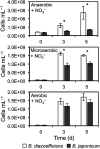Levels of Periplasmic Nitrate Reductase during Denitrification are Lower in Bradyrhizobium japonicum than in Bradyrhizobium diazoefficiens
- PMID: 32554940
- PMCID: PMC7511789
- DOI: 10.1264/jsme2.ME19129
Levels of Periplasmic Nitrate Reductase during Denitrification are Lower in Bradyrhizobium japonicum than in Bradyrhizobium diazoefficiens
Abstract
Soybean plants host endosymbiotic dinitrogen (N2)-fixing bacteria from the genus Bradyrhizobium. Under oxygen-limiting conditions, Bradyrhizobium diazoefficiens and Bradyrhizobium japonicum perform denitrification by sequentially reducing nitrate (NO3-) to nitrous oxide (N2O) or N2. The anaerobic reduction of NO3- to N2O was previously shown to be lower in B. japonicum than in B. diazoefficiens due to impaired periplasmic nitrate reductase (Nap) activity in B. japonicum. We herein demonstrated that impaired Nap activity in B. japonicum was due to low Nap protein levels, which may be related to a decline in the production of FixP and FixO proteins by the cbb3-type oxidase.
Keywords: Bradyrhizobium; cbb3 oxidase; competitive growth; denitrification; periplasmic nitrate reductase.
Figures


Similar articles
-
Anaerobic Reduction of Nitrate to Nitrous Oxide Is Lower in Bradyrhizobium japonicum than in Bradyrhizobium diazoefficiens.Microbes Environ. 2017 Dec 27;32(4):398-401. doi: 10.1264/jsme2.ME17081. Epub 2017 Nov 3. Microbes Environ. 2017. PMID: 29109361 Free PMC article.
-
The nitrate-sensing NasST system regulates nitrous oxide reductase and periplasmic nitrate reductase in Bradyrhizobium japonicum.Environ Microbiol. 2014 Oct;16(10):3263-74. doi: 10.1111/1462-2920.12546. Epub 2014 Jul 11. Environ Microbiol. 2014. PMID: 24947409
-
Effect of Copper on Expression of Functional Genes and Proteins Associated with Bradyrhizobium diazoefficiens Denitrification.Int J Mol Sci. 2022 Mar 21;23(6):3386. doi: 10.3390/ijms23063386. Int J Mol Sci. 2022. PMID: 35328804 Free PMC article.
-
Protein complex formation during denitrification by Pseudomonas aeruginosa.Microb Biotechnol. 2017 Nov;10(6):1523-1534. doi: 10.1111/1751-7915.12851. Epub 2017 Aug 31. Microb Biotechnol. 2017. PMID: 28857512 Free PMC article. Review.
-
Electron transport chains and bioenergetics of respiratory nitrogen metabolism in Wolinella succinogenes and other Epsilonproteobacteria.Biochim Biophys Acta. 2009 Jun;1787(6):646-56. doi: 10.1016/j.bbabio.2008.12.010. Epub 2009 Jan 6. Biochim Biophys Acta. 2009. PMID: 19171117 Review.
References
-
- Aida T., Hata S., and Kusunoki H. (1986) Temporary low oxygen conditions for the formation of nitrate reductase and nitrous oxide reductase by denitrifying Pseudomonas sp. G59. Can J Microbiol 32: 543–547. - PubMed
-
- Bergaust L., Bakken L.R., and Frostegård Å. (2011) Denitrification regulatory phenotype, a new term for the characterization of denitrifying bacteria. Biochem Soc Trans 39: 207–212. - PubMed
-
- Bueno B., Robles E.F., Torres M.J., Krell T., Bedmar E.J., Delgado M.J., and Mesa S. (2017) Disparate response to microoxia and nitrogen oxides of the Bradyrhizobium japonicum napEDABC, nirK and norCBQD denitrification genes. Nitric Oxide 6: 1–13. - PubMed
MeSH terms
Substances
Supplementary concepts
LinkOut - more resources
Full Text Sources
Molecular Biology Databases
Research Materials

